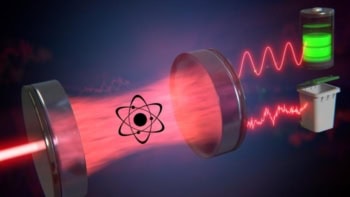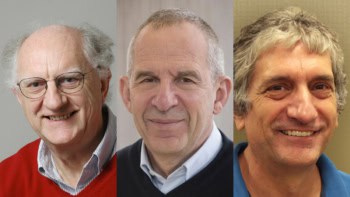Everyday experience - and Newton's first law of motion - tells us that a billiard ball rolling in one direction cannot spontaneously start to move in the opposite direction. But such rules do not apply in the quantum world, where atoms have been seen performing this trick - known as 'dynamical tunnelling' - according to two teams of physicists. The teams found that atoms can jump back and forth between two stable states of motion that have equal and opposite momentum, without passing through the zero momentum state that separates them (W Hensinger et al 2001 Nature 412 52, D Steck et al 2001 Sciencexpress 1061569).
We often think of quantum tunnelling in terms of the ‘marble and the mountain’. If you flicked a marble towards a mountain, you would not expect it to roll over the top. But a quantum particle confined to a similar region of low potential energy can ‘tunnel’ through the mountain – or potential barrier – that confines it. This feature of quantum mechanics arises because the wave-like nature of the particle means that it is smeared out in space.
The wavefunction of the particle describes the probability of finding it in a certain region of space. This probability is non-zero beyond the potential barrier, which gives the particle a chance of appearing on the other side of it – that is, ‘tunnelling’ through it. However, in dynamical tunnelling – a phenomenon that was predicted to exist in the 1980s – there is no potential barrier, although classical mechanics forbids particles from changing from one state to the other.
Mark Raizen led the team at of the University of Texas at Austin, while Bill Phillips of the National Institute of Standards and Technology collaborated with researchers at the University of Queensland in Australia. Both groups used a similar optical technique to demonstrate dynamical tunnelling. Around a million atoms are trapped in an ‘optical lattice’, which consists of criss-crossed laser beams. The electric component of the laser light induces a dipole moment in the atoms, which draws them to the regions of maximum intensity in the lattice. The atoms are also chilled to within a few nanoKelvin of absolute zero to eliminate thermal vibrations that would obscure quantum effects.
Once the atoms are gathered into these pockets and placed into the same initial quantum state, the intensity of the laser light is made to oscillate at 250 kilohertz. The momentum of the atoms is measured at intervals during this modulation, using an absorption imaging technique. Both teams found that the momentum of the atoms changed back and forth as the intensity fluctuated – but did not pass through an intermediate zero-momentum phase.
The fact that the atoms bypassed the zero-momentum state means that the atoms were effectively in both momentum states at the same time during the transition from one state to another. This is an example of ‘quantum superposition’, the phenomenon that could form the basis of a quantum computer.
The experiments also hint at a new effect dubbed chaos-assisted dynamical tunnelling. Regions of chaos are present in the optical lattice, and both groups found evidence that this effect – which is common in the macroscopic world – can help atoms to flip between the opposite states of momentum.



